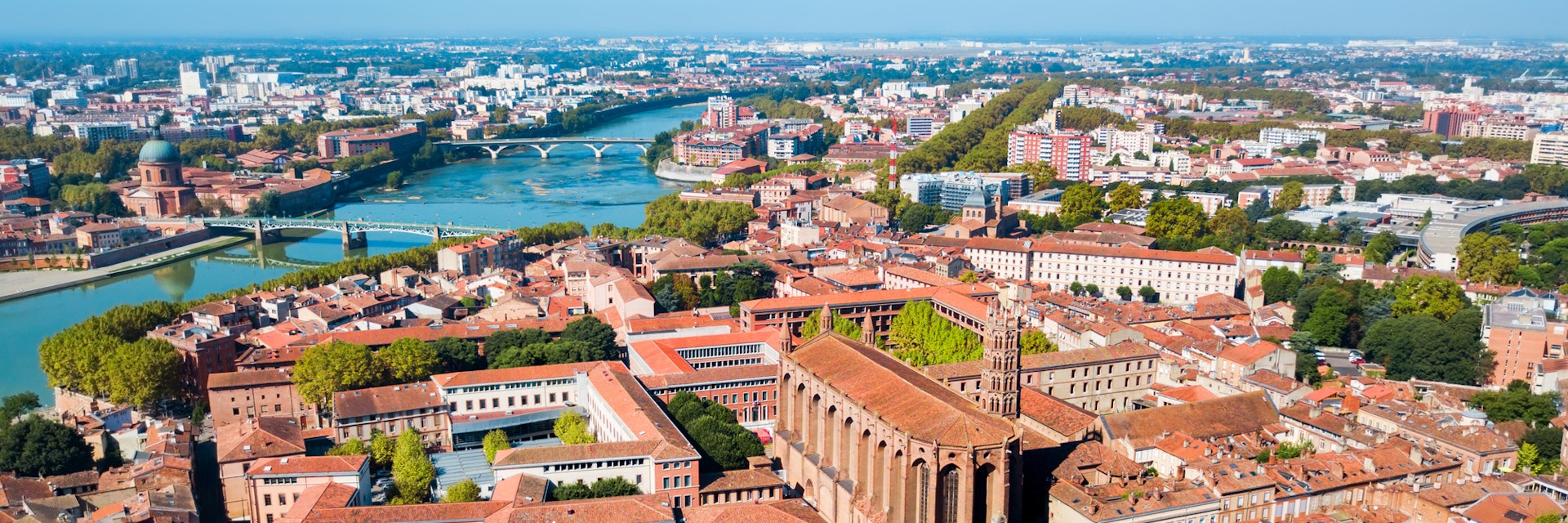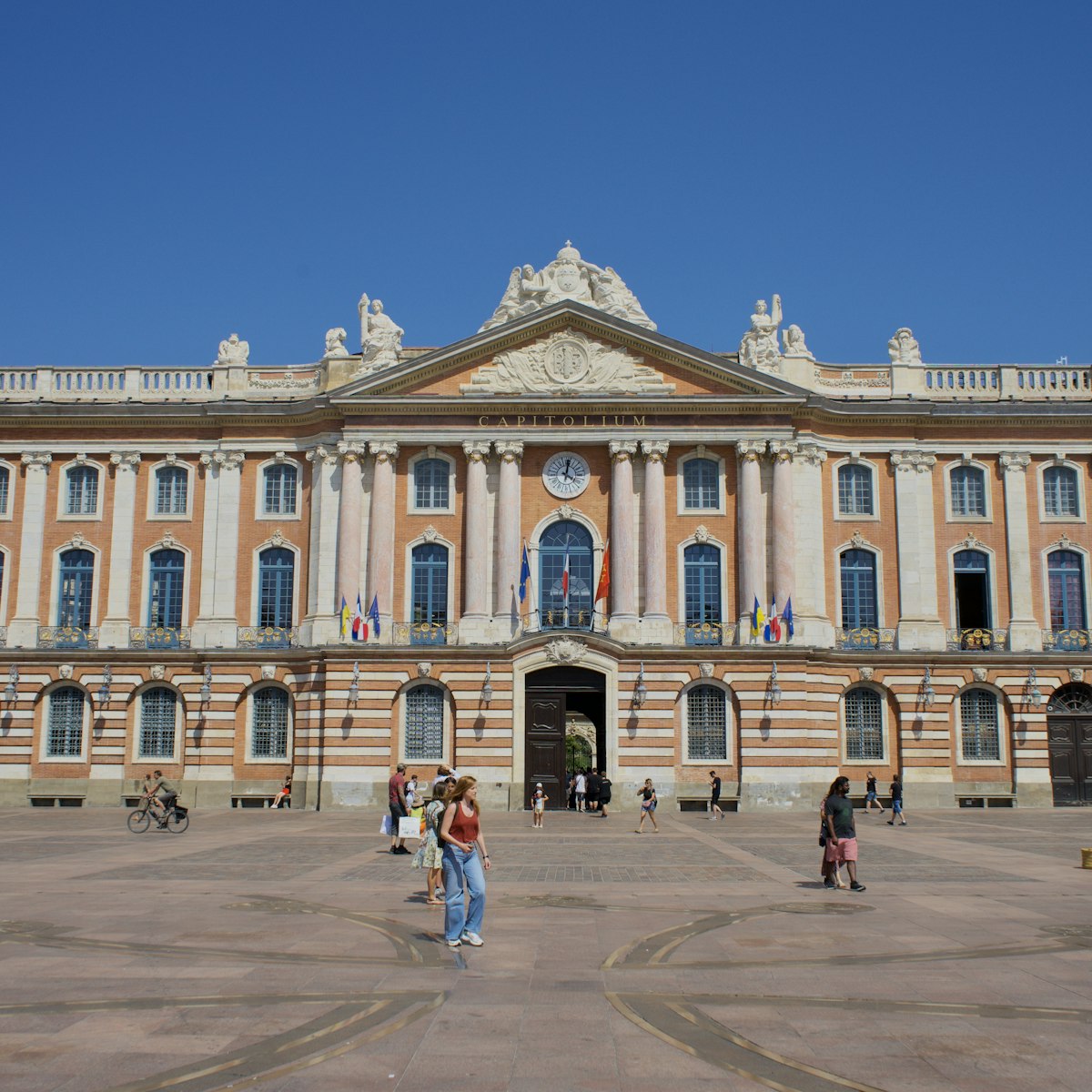From its seven-story octagonal bell tower to the palm tree-shaped vaulted ceiling, the Couvent des Jacobins is one of Toulouse’s oldest and most recognizable buildings. It’s also built in the traditional brick style of Southern French Gothic, and its imposing nave blends in seamlessly with the rest of the neighborhood.
Construction started back in 1230, and almost 800 years later it remains an essential part of life in Toulouse and one of France’s more arresting sights on first entering. But despite its free entry, the crowds here are never too busy, and its unique design and slightly bizarre history make the Couvent des Jacobins an intriguing visit.
Insider tip
Need a languid escape from Toulouse’s intense summer sun? It’s €5 to enter the secluded cloister behind the Couvent, and the back wall on the far side has a row of 15 deck chairs. They’re all shaded underneath a wooden canopy and are ideal for both admiring the garden view and cooling down.
How much time you need to visit Couvent des Jacobins
If you have 30 minutes
If you’re in a hurry, then head through the warren of narrow backstreets hiding the Couvent and enter through the left-hand side entrance, where your breath may be taken away but the cavernous size of the interior. Unlike most church naves, this one is quite sparse inside, and the eye is drawn to the enormous palm-shaped columns (Le Palmier des Jacobins) in the center that fan out across the ceiling in staggered black and red blocks, reaching spider-like onto the steep walls.
Those walls are spectacular too, housing enormous pencil-shaped stained glass windows that allow natural light to come pouring in. At certain times in the morning, the oranges, reds, golds and greens of the windows bleed onto the back wall, like a glowing projection. The northern side of the Couvent features several dramatic religious paintings dating from between the 13th and 15th centuries, while under the altar are the relics of Saint Thomas Aquinas.
There are a host of benches in the center next to a small set of flickering candles that allow you to crane your neck and truly take it all in.
If you have 1 hour
With a bit of extra time, make your way out into the serenity of the four-winged cloister, with its Tuscan Cypress trees rising from the middle of the miniature garden maze. Not only is the cloister a wonderful spot to relax; the columns flanking the sides are remarkably photogenic and provide a nice view up to the bell tower (which isn’t easy to see from the regular entrance).
Occasionally there will be a pianist playing within the cloister corridors, though usually the only noise comes from the cooing of the pigeons as they flutter from roof to roof. Between July and August, the western side of the cloister features tables with Medieval chess-like games available to play (with rules laid out next to them).
If you have half a day
Take advantage of the other rooms attached to the cloister, especially the revolving exhibitions in the refectory room on the northern wing, which often cover some interesting subjects (most recently a look at the gaudy costumes used in The Phantom of the Opera). These will change depending on the time of year you’re there.
Nearby on the east wing is the enormous arched door that leads into the Chapter House. Built between 1299 and 1301, it contains palm tree columns like miniature versions of those in the nave, while the plastered walls create the illusion of tiles.
History of Couvent des Jacobins
The Couvent des Jacobins was the mother church of the Dominican Order, a small community of monastic preachers founded by Saint Dominic to combat the heresy of Christian Catharism. They needed somewhere to preach and decided to build this elegant ecclesiastical building in 1229 from pink Roman brick (though the church’s earlier incarnation was only half as tall).
The Couvent expanded over the next 200 years, and in 1368 Pope Urban V decreed that the relics of Saint Thomas Aquinas – a member of the Dominican Order – could be transferred from Italy to Toulouse.
Following the French Revolution of 1789, the Dominican Order was banned, and the friars were forced to leave. By 1810, the emperor Napoleon had converted the building into barracks to help in his various military campaigns. The next 150 years saw the Couvent take various forms – housing an exhibition of Arts and Industries in 1865, serving as a school playground in 1872 and as a safehouse for storing treasures from the museums of Paris during World War II.
After all these odd jobs, the Couvent spent much of the second half of the 20th century in a state of renovation to restore it to its former glory, and it finally (partially) reopened as a museum in the 21st century.
Tickets and other practicalities
The Couvent des Jacobins is free to enter, though the cloister costs an extra €5 to explore (it’s also the only part of the building that contains toilets).
The Couvent des Jacobins is closed on Mondays, but open every other day of the week, including weekends. 45-minute guided tours can be taken in English – usually on Fridays – but check ahead on the website. They’re €8 for adults.
Mornings are better to visit, not just because it’s quieter, but also because the light from the stained glass windows hits the walls with bright intensity.









